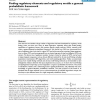Free Online Productivity Tools
i2Speak
i2Symbol
i2OCR
iTex2Img
iWeb2Print
iWeb2Shot
i2Type
iPdf2Split
iPdf2Merge
i2Bopomofo
i2Arabic
i2Style
i2Image
i2PDF
iLatex2Rtf
Sci2ools
BMCBI
2007
2007
Finding regulatory elements and regulatory motifs: a general probabilistic framework
Over the last two decades a large number of algorithms has been developed for regulatory motif finding. Here we show how many of these algorithms, especially those that model binding specificities of regulatory factors with position specific weight matrices (WMs), naturally arise within a general Bayesian probabilistic framework. We discuss how WMs are constructed from sets of regulatory sites, how sites for a given WM can be discovered by scanning of large sequences, how to cluster WMs, and more generally how to cluster large sets of sites from different WMs into clusters. We discuss how 'regulatory modules', clusters of sites for subsets of WMs, can be found in large intergenic sequences, and we discuss different methods for ab initio motif finding, including expectation maximization (EM) algorithms, and motif sampling algorithms. Finally, we extensively discuss how module finding methods and ab initio motif finding methods can be extended to take phylogenetic relations be...
| Added | 12 Dec 2010 |
| Updated | 12 Dec 2010 |
| Type | Journal |
| Year | 2007 |
| Where | BMCBI |
| Authors | Erik van Nimwegen |
Comments (0)

